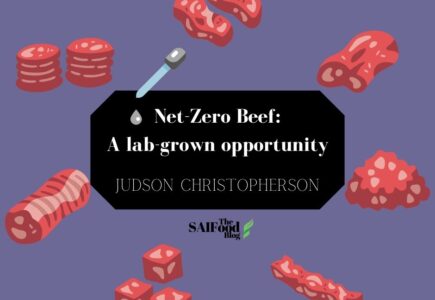Lab-Grown Meat
Lab-grown meat came onto the scene a decade ago and was touted as a potential solution to some of the most critical issues facing humanity, such as improving economic prosperity, food security, and environmental sustainability throughout the agri-food supply chain. A more technical term for the product is cultured meat, as the product is grown from animal stem cells that are cultured with nutrients and chemicals to foster cell growth into muscle tissue. The technology was projected to be pivotal, altering the food production system to lessen the pangs of world hunger while improving animal welfare. The foremost issue lab-grown meat was anticipated to combat was climate change, with initial estimates flaunting 96% reductions in CO2 emissions, 99% less land use, and 45% percent less energy than its conventional counterpart.
At its initial release, cost was the principal barrier to adoption, with a single burger costing $330,000 to produce in 2013. However, in the past 10 years, significant innovation, scaling, and decreased material costs have occurred, facilitating production cost reductions. More recent estimates place costs at $9.80 per burger which is still too high for mass adoption but displays the rapid cost reduction in a decade. Nonetheless, the industry still has a long way to go before consumers would be enticed by the price point of lab-grown beef. As costs decrease, technology improves, and lab-grown meat becomes indistinguishable from its once walking counterpart, consumers may be attracted to lab-grown meat as the sustainable option.
Or will they?
Preliminary research performed at the Davis campus of the University of California, has shown that the negative environmental impact of cultured meat may be many times greater than its natural competitor. Current production methods require growth media be refined and purified to the same extent as pharmaceutical processes, using significant resources and making the global warming potential of cultured beef higher than conventional beef. The global warming potential of cultured meat ranges from four to 25 times that of animal-derived beef. Even if the process is improved to use food-grade media in place of pharmaceuticals, cultured meat may still be worse for the environment. This research remains in the peer review process but may be published in the coming months. So, if the technology designed to replace animal agriculture in its entirety may not be worth the petri dish it was grown in, where will net-zero beef come from?
The Beef Industry: Innovation on the Horizon
Today, it’s difficult to find nutritional advice, climate-focused research, a dinner recipe, or even a weather app that isn’t trying to sway consumers away from beef consumption. Often, reducing beef intake is touted to reduce one’s carbon footprint. In reality, the best way to ensure you get the protein, vitamins, and minerals you need while combatting climate change may be to purchase those sirloin grilling steaks or pound of hamburger.
Currently, cow-calf production on the vast native grassland prairies and seeded forage lands protect our watersheds, riparian areas, and the natural habitats of wildlife, including pollinators. Further, the grazing of marginal lands used for grazing and forage production can sequester significant amounts of carbon, improving the sustainability of the industry.
A key point is that the best economic, environmental, and sustainable use of marginal land is often grazing or fodder production. However, the main barrier to producing net-zero beef is enteric emissions , but a solution may be closer than originally thought. 3-nitrooxypropanol, or 3-NOP, is a relatively novel feed additive being used in Chile, Brazil, and was most recently approved in the EU. In a Canadian study, 3-NOP was found to reduce methane emissions in feedlot steers by over 20%. Given that a significant proportion of emissions arising from beef production are enteric methane, a 20% reduction in these emissions would greatly improve the sustainability of the industry. In fact, research analyzing the entire lifecycle of beef production with Canada’s whole-farm modelling tool, Holos, it was projected that when forage crops were recently reseeded into previously cropped land on cow-calf operations the production cycle was an emission sink. Combine technologies like 3-NOP with improved grassland management and the beef industry could become a net sink of GHGs from gate to plate.
The Pathway to Net-Zero Beef
Combining 3-NOP with proper land stewardship appears be the path forward for sustainable steak. However, implementation in Canada may be years away if bureaucratic red tape and slow approval processes hinder the arrival of the feed additive. A myriad of alternatives to 3-NOP with similar emission reduction potentials are being explored. According to Agriculture and Agri-Food Canada, alternate methods include improved feeding strategies, other feed additives, higher nutritional value of forages, and improved livestock genetics to decrease feed requirements. It appears that the stockman will not face eradication at the hands of a petri dish, despite what some may wish for. After all, the initial benefits associated with lab-grown beef have yet to come to fruition and it is projected they will not be achieved any time soon, especially as a rapidly developing beef industry searches for ways to ensure the sustainability of the sector.

